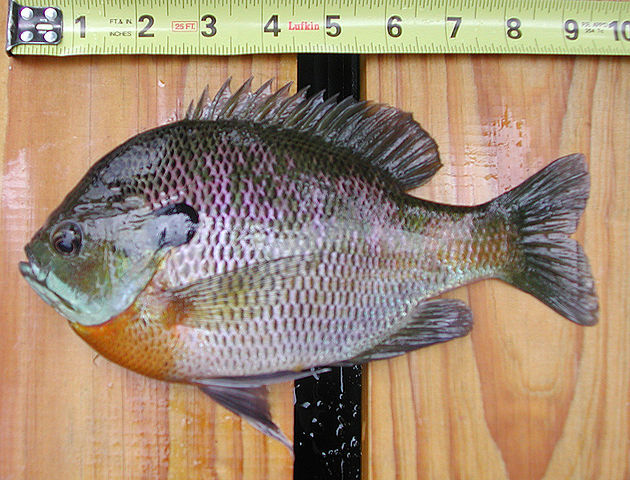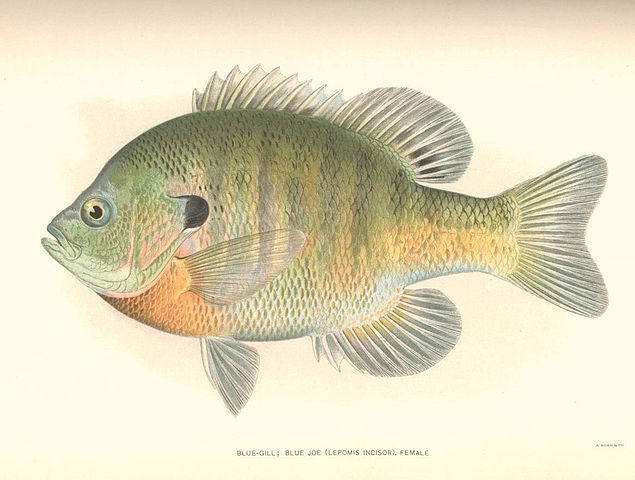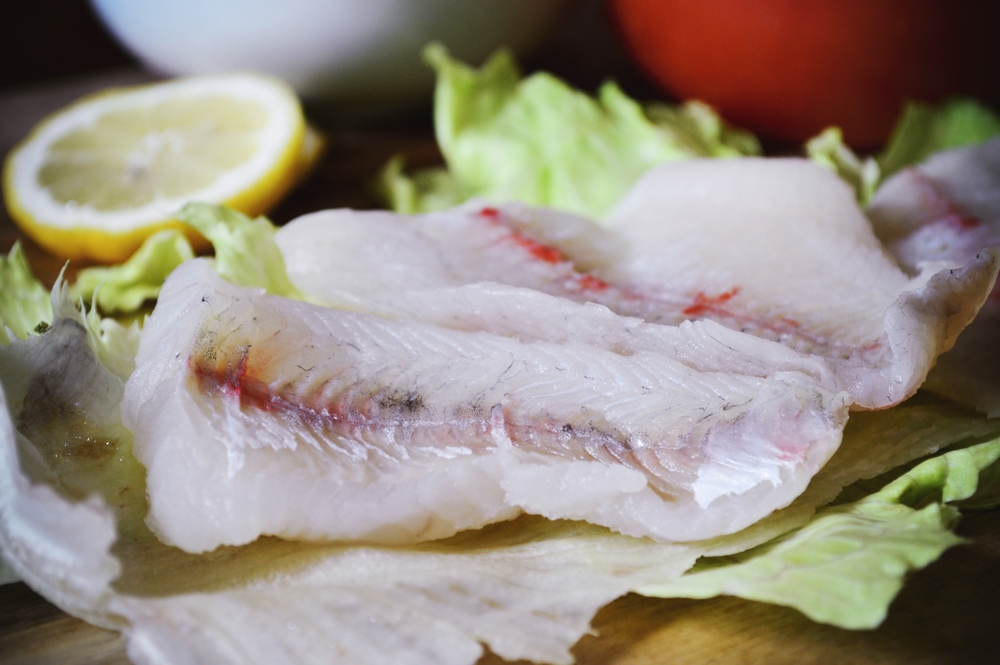This article may contain affiliate links. If you make a purchase after clicking on a link we may earn a small commission at no extra cost to you. As an Amazon Associate, I earn from qualifying purchases.
Can You Eat Bluegill?

It’s common for many anglers to wonder whether or not they can cook and eat bluegill. The short answer is, yes, but there are some specific things you should know before you attempt to clean and cook bluegill.
If you’re going to eat any type of fish, it’s important to understand the best way to cook that species for optimal results. In this article, we’ll discuss the different ways people often clean and cook bluegill.
What are Bluegill?
Many freshwater anglers throughout North America often catch and cook bluegill. They are found in abundance throughout much of the United States and Canada and they are very easy to catch, which makes them a good target fish for beginner anglers.
Bluegill are known under the scientific name Lepomis macrochirus. They are part of the Sunfish family, which includes more than 30 different species of panfish that are highly-prized by freshwater anglers for a number of reasons.
Bluegill are the most common species within the Sunfish family as they often thrive in almost any type of freshwater environment. They are native to the river systems throughout the southeastern United States, but bluegill have since been introduced to lakes, rivers and small ponds all across the North American continent.

They usually grow to be roughly 10 inches in length and the average bluegill often weighs around 1 or 2 pounds at full maturity. In the right conditions and with a good diet, bluegill are known to reach sizes of more than 12 inches in length. Any specimen that weighs in excess of 2.5 pounds is considered by serious anglers to be a trophy-sized bluegill.
Can You Eat Bluegill?
Yes, you can eat bluegill and they are actually considered by many anglers to be one of the finest freshwater delicacies you’ll find in North America’s lakes and rivers. There are a variety of different ways you can clean, prepare and cook bluegill that will bring out their flavor in the best ways.
There are no risks associated with consuming bluegill meat as you might expect with some species of fish. Bluegill are actually prized as one of the top panfish species to eat due to their clean diet and the fact that they prefer to live in clean, clear water.
Bluegill were a favorite target among pioneers and settlers in North America hundreds of years ago. They were highly sought-after and the fact that bluegill can be found in nearly any freshwater body of water.
Unlike other species such as bass, walleye and others, bluegill are relatively simple to catch and you can usually see them swimming around the edge of lakes and rivers where they are found.
What Does Bluegill Taste Like?
Many avid freshwater anglers consider bluegill to be one of the best-tasting fish you’ll find in North America’s waters. Compared to species like bass, walleye, muskie and others, bluegill offer a firm and flaky texture that is packed with flavor.
Their meat has a mild taste that is not strong or too fishy, which makes it one of the top species for introducing someone who’s never eaten freshwater fish before.

There is considerable debate among panfish anglers as to whether crappie or bluegill offer the best taste when it comes to freshwater fish.
Both species offer truly exceptional taste and meat quality, but bluegill typically have the best flavor regardless of how they are prepared and cooked. One of the main reasons why so many anglers overlook bluegill or don’t want to bother with cleaning and preparing a small filet.
How to Clean Bluegill
There are various schools of thought when it comes to the best way to clean bluegill. Since they are one of the smaller varieties of freshwater fish you’ll find in North America, most anglers don’t want to go through the trouble of cleaning and filleting such a small specimen.
However, those who do are often rewarded with an outstanding culinary delicacy that you can’t get anywhere else.
If you’re someone that prefers to filet their fish before cooking, you’ll need a sharp knife and a steady hand to filet bluegill. The most obvious difficulty in filleting bluegill is the small size of the fish, which leaves little room for error and makes it a true challenge to get a decent amount of meat off the fish’s bones without wasting any.
If you’re going to filet a bluegill, it’s usually best to have an electric filet knife as this will allow you to cut deeper into the fish without having to bear down as much as you would need to with a traditional filet knife. You should work to filet a bluegill just like you would any other fish by starting with your blade just behind the bluegill’s pectoral fin.

Cut down into the fish until you reach the spine and then angle your knife toward the tail while making sure to keep the blade as close as possible to the fish’s spine. Once you have fully flayed the fish open, you’ll want to cut into the base of the tail and continue working the blade back until you separate the skin from the meat.
Be careful to keep your knife blade between the skin and the filet in order to get as much meat as possible. Use the standard method of removing the small bones and flesh from along the bottom of the filet as you would for any other fish.
Can You Eat a Bluegill With the Skin On?
Yes! In fact, leaving the skin intact is one of the best ways to preserve as much of the bluegill’s outstanding flavor as possible. If you’re going to use this method, you’ll need to ‘scale’ the bluegill before cooking them. To do this, you can use a fish scaler tool, a spoon or a dull knife.
Scaling a bluegill is a more time-consuming process, but it offers a truly unique way of cooking these tasty fish that is considered to be a delicacy in the Deep South as many people will fry the bluegill with their skin, fins and tail still intact.
If you’re going to use this method, be sure to cut the bluegill’s head completely off by making an incision just behind the pectoral fin. Also, be sure to remove the fish’s guts and wash thoroughly before placing it in the batter or into the frying pan.
Best Bluegill Recipes
As we’ve already mentioned, there truly isn’t a wrong way to cook a bluegill. These small, but tasty fish offer a flavorful meal in just about any way you want to cook them. If you’re looking for some of the best bluegill recipes, there are plenty of online sources that offer great recipes for beginners, as well as seasoned experts.
You can find a great recipe for scaled bluegill here that’s relatively easy to prepare and cook. If you’re going to use this recipe, be sure to carefully remove all of the scales from each side of the bluegill, as well as the guts and innards before cooking.
For those who have an affinity for fried bluegill, there are plenty of recipes and cooking methods you can use. In fact, most standard fried panfish recipes will work exceptionally well with bluegill filets, but this Pan-Fried Bluegill Recipe is one that is well-worth a try.
If you’re looking for a recipe that’s more healthy than the typical fried fish cuisine, here’s a link to 3 Simple and Easy Panfish recipes that do not involve frying your catch. Even when the filets are grilled, baked or even air-fried, it’s hard to find a better-tasting fish than bluegill.
Can You Eat Bluegill Raw?
One of the most common questions asked by beginners and those who are largely unfamiliar with panfish and bluegill is whether or not these fish can be eaten raw.
There are many fish that can be safely consumed raw as long as you are very careful to clean your meat and check to make sure there isn’t a great risk of encountering dangerous parasites.
It’s generally not recommended that you eat raw bluegill as there are many unanswered questions regarding the body of water where the fish was caught, as well as the presence of any sort of infection that would contaminate the meat.
Bluegills typically do not succumb to the types of parasites that other fish encounter because their diet consists of a wide variety of different creatures instead of mostly other small fish.
The short answer to this question is yes, you can eat raw bluegill, but do so with extreme caution.
Conclusion
If you’ve never eaten bluegill before, you should certainly place this species next on your list of freshwater fish to try cooking and eating.
This article should serve as a guide for cleaning, preparing and cooking bluegill in a way that will be favorable to anyone’s tastes. Like most anglers, once you get a taste for bluegill, you’ll understand why they are America’s favorite panfish.
